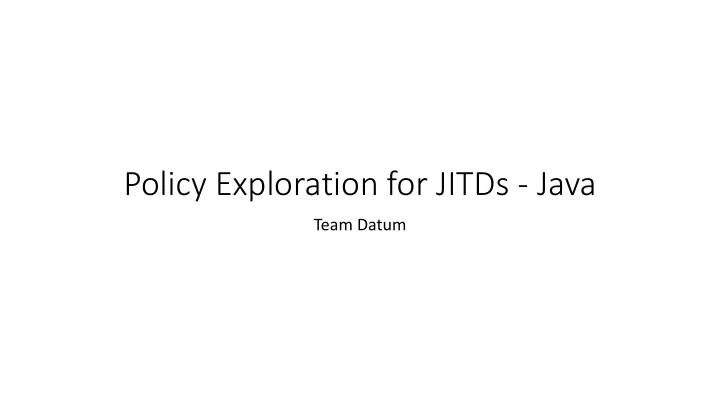

Policy Exploration for JITDs - Java Team Datum
Splaying on Uniform Distribution Cracking on Uniform Distribution Cracking on Uniform Distribution splaying for every 100reads without splaying Time Taken ~ 26.8ms Time Taken ~ 31.8ms Tested as KeyRange 1000000 Load 1000000 Reads 1000
Splaying on Zipfian Distribution Cracking on zipfian Distribution Cracking on zipfian Distribution splaying for every 500 reads without splaying Time Taken ~ 421 ms Time Taken ~ 309 ms Tested as KeyRange 1000000 Load 1000000 Reads 1000
JITD C Group Alex, Razie, Aurijoy
Some Recaps ● Comparison between Java and C version for JITDs ● Splaying policy
Java and C Performances
However over a 1000 Reads Things Are Better
Splaying policy- preliminary findings
Let’s see if Splaying by itself (at random) is good! The setup: ● Buffer Size of 1000000 ● Data is Randomly Distributed ● Key Range of 1000000 ● Total Reads 10000 ● We test splaying on every 250, 500, 1000 reads ● Our results here are the average of 5 separate runs (results were pretty consistent across runs)
How do we choose the random point to splay at? ● We choose it while we do a read ● We single out the cog generated while cracking for the left hand side ● We use the cog generated for the read just before we splay Why? ● It’s for free unlike finding the median ● It’s random
How does it perform per splay step?
How does it perform in terms of runtime?
Takeaway ● Splaying at random works great as splaying balances the tree pretty good regardless ● It may thus be better that our policy uses splaying as more of a balancing technique ● Splaying more often is better ● There is probably a cutoff point and we should find it
Tinkering with Splaying Interval- Variations of Splay Heuristic Our efforts would be directed towards finding the variations over different splaying heuristics. While the splaying policies used so far are not the ones used in canonical splay trees used widely. We hope to get an idea of whether the intervals do matter over uniformly mapped zipf keys.
ReMapping the Keys in a Zipfian to have fair Prior over Tree Balancing Previous week our choice of mapping the numbers generated by the zipfian had an initial bias. Keys with successive numbers had bias for being the actual successors in the balanced splay tree. So we decided to remove the bias by remapping the key-values after a shuffle. This would eliminate inconsistencies in the splay interval results over the zipfian.
Should we experiment with Dynamic Balancing Strategies One of our major concerns in policy design is being able to guarantee bounded expectations over latency vs throughput. So could we turn the problem over itself and by means of hierarchical balancing strategies to have guarantees on bounds. Our context so far has been read heavy workloads so our policies effectively translate into search structures.
Exploring More Interesting Workloads While there is a tendency to design policies intended for different distributions remain high. We would like to point out that the most important distributions for our purpose are the ones naturally occurring as workloads. So it is sufficient to say that our efforts are directed towards exploring important workloads and designing policies around them. So far we have only modelled around a uniform and a zipfian distribution, we hope to find more important benchmark distributions from YCSB.
JITDs on Disk Team Warp Animesh, Archit, Rishabh, Rohit
SuMMARY TILL CHECKPOINT 1 Explored and implemented different file formats ● Explored different ideas to store indexes on disk ● LSM Trees ○ Paging ○
FILE FORMATS AND SAVING DATA TO FILE Different Cogs have different structure ● Using Visitors Pattern to write different Cogs ● Iterative algorithm to restore indexes/pages ● Two file formatters used ● Working on policies to use both the file formats in ● conjunction to avoid fragmentation
Detailed File Format For INDEX FILE As Stored in FILE SYSTem Cog Type Meaning DATA SEPARATOR DATA A Array Cog COG TYPE FILE NAME ROOT FLAG COG TYPE VALUE COG TYPE FILE NAME B BTree Cog SIZE (BYTES) 2 50 1 2 8 2 50 C Concat Cog TYPE Char Char[] Bool Char Long Char Char[] E Empty F File Cog L Leaf Cog S SubArray Cog
Detailed File Format For INDEX FILE As Stored in FILE SYSTem Cog Type Meaning DATA SEPARATOR DATA A Array Cog COG TYPE FILE OFFSET COG TYPE VALUE COG TYPE FILE OFFSET B BTree Cog SIZE (BYTES) 2 4 2 8 2 4 C Concat Cog TYPE Char Integer Char Long Char Integer E Empty F File Cog L Leaf Cog S SubArray Cog
LSM TRees Timely flushing index tree in memory to disk ● Merging these files together to main index file ● Problems ● Merging was very complicated ○ Restoring partial trees based on queries were ○ problematic
PAGING Refined the concept of saving and restoring partial ● indexes into the concept of paging Page-In indexes based on queries ● Page-Out indexes based on available memory ● Current Progress ● Bug Fixing ○ Coming up with benchmarks ○ Policies based on which pages should be paged-out ○
QUESTIONS?
Recommend
More recommend